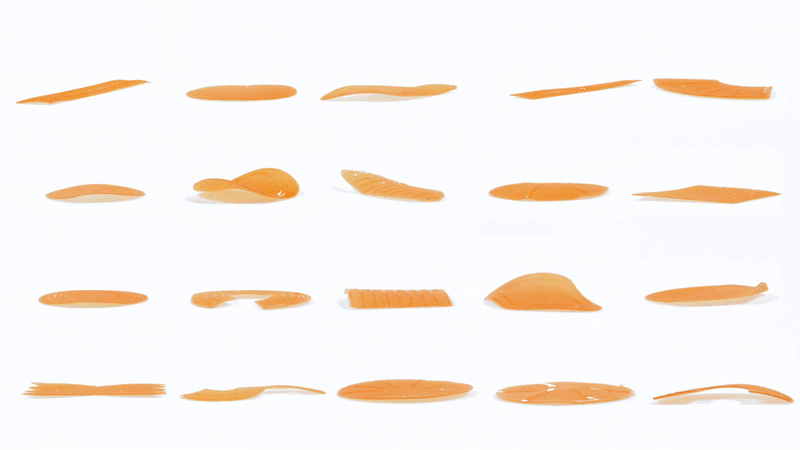In transport all pasta are flat. At the time of serving, you just need to put them in the water to have pasta that change it’s shape. This is the concept of MIT’s “Transformative Appetite” project, showing that even in a simple noodle it is possible to innovate.
Imagine um “origami da comida”, em que formas planas 2D se dobram instantaneamente em objetos 3D quando colocados na água. Inovação é resolver problemas e este aqui partiu do seguinte: mesmo se você embalar macarrão perfeitamente, ainda vai acabar com 67% do volume do pacote como ar.
Imagine a “food origami,” in which flat 2D shapes instantly bend into 3D objects when placed in the water. Innovation is solving problems and this one started from the following: even if you pack noodles perfectly, you will still end up with 67% of the package volume like air.

O time formado por uma parceria entre o MIT Media Lab e a aceleradora Food + Future formulou um novo tipo de massa de gelatina, celulose e amido para resolver este problema. As grandes vantagens são: reduzir a quantidade e tamanho das embalagens e diminuir os custos com transporte. Além disso, a própria experiência de ver as massas se transformando pode ser interativa e divertida para o consumidor.
The team formed by a partnership between MIT Media Lab and the accelerator Food + Future formulated a new type of gelatin, cellulose and starch paste to solve this problem. The great advantages are: reduce the quantity and size of the packages and reduce the costs with transport. Moreover, the very experience of seeing the changing masses can be interactive and fun for the consumer.
How does it work?
Wen Wang e Lining Yao, os pesquisadores, começaram o estudo investigando como diferentes materiais respondem à umidade. A massa plana, impressa em impressora 3D possui duas camadas com densidades e composições diferentes diferentes (impressora 3D de comida? Sim, falamos sobre ela aqui,olha lá!). A camada superior é mais densa e absorve mais água que a inferior. Assim quando a estrutura é imersa, a cama de cima enrola a de baixo, formando arcos.
Wen Wang and Lining Yao, the researchers, began the study investigating how different materials respond to moisture. The flat mass, printed in 3D printer has two layers with different densities and different compositions (3D food printer? Yes, we talked about it here, look there!). The upper layer is denser and absorbs more water than the lower layer. So when the structure is immersed, the top bed rolls up the bottom, forming arches.
And the taste? Is it good?
A equipe testou o produto com chefes de cozinha e a parceria rendeu novos pratos. Eles garantem que o sabor e a textura são bons, mas ainda não parecem macarrão. Por isso já estão em contato com a fabricante italiana Barilla, para estudar maneiras de fazer com que se pareça uma massa convencional.
The team tested the product with chefs and the partnership yielded new dishes. They guarantee that the taste and texture are good, but they still do not look like noodles. So they are already in contact with the Italian manufacturer Barilla, to study ways to make it look like a conventional dough.

Pasta with tomato and herbs – chef Matthew Delisle
Para o futuro eles esperam que os consumidores possam criar suas massas e personalizar como quiserem (olha aí o conceito de produtos ultra personalizados de novo – aqui) a partir do software já desenvolvido por eles.
Será incrível se conseguirem uma massa com sabor tradicional, mas se não conseguirem, por que não abraçar a imperfeição e fazer dessa uma massa diferente, um novo produto? Assim como o bifum (macarrão de arroz) não é igual ao spaghetti italiano e nem pretende ser, as massas que mudam de formato podem criar um novo mercado, com receitas inéditas e uma legião de novos consumidores fãs de novidades.
For the future they hope consumers can create their masses and customize them however they want (look at the concept of ultra-customized products again – here) from the software already developed by them. It will be amazing if they get a traditional flavored pasta, but if they can not, why not embrace the imperfection and make a different mass a new product? Just as bifum (rice noodles) is not the same as the Italian spaghetti and is not meant to be, the pasta that changes shape can create a new market, with unprecedented recipes and a legion of new consumers fans of news.

Bifum e spaghetti: pasta so differently tasteful and delicious.
References: Springwise, MIT News, Next Nature, Dezeen, EurekAlert, O Estado de São Paulo


COMMENTS